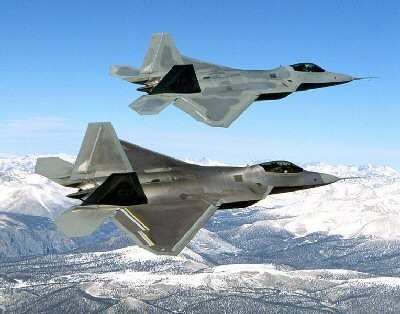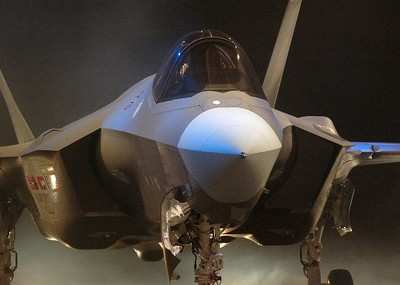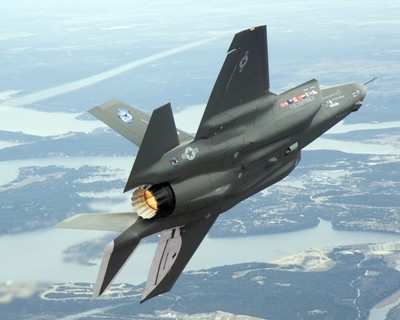Which NextGen Fighter Will Pentagon Chose?
A battle is brewing in Congress, over whether the F-22 Raptor or
the F-35 Lightning II Joint Strike Fighter should be selected to
replace the US Air Force's aging fleet of F-15 Eagles.

According to Defense Times, US Deputy Defense Secretary Gordon
England clashed with Democratic lawmakers on the House
Appropriations defense subcommittee Wednesday,
over which aircraft would be selected. England is among those who
want the F-22 production line shut down, after 183 Raptors are
produced, in favor of the F-35; but some lawmakers, including the
panel’s vice chairman, Washington Congressman Norm Dicks,
want to order more Raptors.
Each side has its strong and weak points. Raptor supporters note
it's the plane the Air Force wants -- the service has asked for as
many as 381 of the advanced, highly-maneuverable fighters -- and,
it's already in production. But the plane is also pricey, at around
$120 million per airframe... and has yet to see actual combat
duty.
The F-35 is still in development... and while it's per-plane
cost is expected to be much cheaper than the F-22 (to the tune of
"only" $35 million), the development program has run over budget to
the tune of $299 billion -- making it by far the Pentagon's single
most expensive weapons expenditure.

As originally designed, both aircraft were also designed with
different roles in mind. The Raptor was conceived as an air-to-air
superiority fighter, along the lines of the original F-15 in the
1970s and 80s; whereas the F-35 was developed primarily as a ground
attack aircraft, closer in spirit to the latest F-15E Strike
Eagle.
During this week's hearing on the White House's 2009 defense
budget proposal, Dicks questioned the move to defer a final
decision on shutting down F-22 production to the next
administration, and diverting that estimated $400 million to
programs aimed at keeping F-15s in the air -- despite the recent
discovery of serious airframe issues with the oldest Eagles.
"Shouldn't you have done one or other?" he asked England, on the
choice to purchase more Raptors, or shutting down the production
line.

"To be blunt, the Air Force has spent $65 billion and you have
183 planes," replied England, who sat on the hearing in place of
Defense Secretary Robert Gates, who broke his shoulder slipping on
ice earlier this week. "Look, at some point, we have to buy" the
cheaper fighter, he added.
On Tuesday, England told the Senate Budget Committee he doesn't
consider the F-22 to be a suitable replacement for the F-15. "So I
would expect instead we would try to accelerate the Joint Strike
Fighter, which is more the class of the F-15," he said, according
to Reuters. "So the Air Force would move into Joint Strike Fighter
and not into the much more expensive F-22 airplane."
Pennsylvania Congressman John Murtha, an F-22 supporter, says
England's math is misleading... as it doesn't consider discounts on
volume production of the Raptor. If the Air Force is allowed to
purchase the 381 planes it wants, he said, the per-jet price could
drop as much as "10 or 12 percent" -- a number that still
represents a much larger outlay than the JSF, he admits.
Murtha stressed he would only support buying additional Raptors
if the Air Force "is convincing" in selling the need for the F-22's
capabilities in combat.
"The department believes [the service] has enough" F-22s, Murtha
told reporters after the hearing. "The Air Force is trying to prove
to the committee -- and we'll have hearings later on -- to tell us,
'These are the threats.'"

That's a sizable challenge... as the Air Force must convince
lawmakers to plan ahead, for potential conflicts with such
superpowers as China or Russia, and their advanced aircraft, rather
than the current threat by ground-based al-Qaeda.
 ANN's Daily Aero-Linx (04.13.24)
ANN's Daily Aero-Linx (04.13.24) ANN's Daily Aero-Term (04.13.24): Beyond Visual Line Of Sight (BVLOS)
ANN's Daily Aero-Term (04.13.24): Beyond Visual Line Of Sight (BVLOS) Airborne 04.09.24: SnF24!, Piper-DeltaHawk!, Fisher Update, Junkers
Airborne 04.09.24: SnF24!, Piper-DeltaHawk!, Fisher Update, Junkers Aero-News: Quote of the Day (04.14.24)
Aero-News: Quote of the Day (04.14.24) ANN's Daily Aero-Term (04.14.24): Maximum Authorized Altitude
ANN's Daily Aero-Term (04.14.24): Maximum Authorized Altitude






